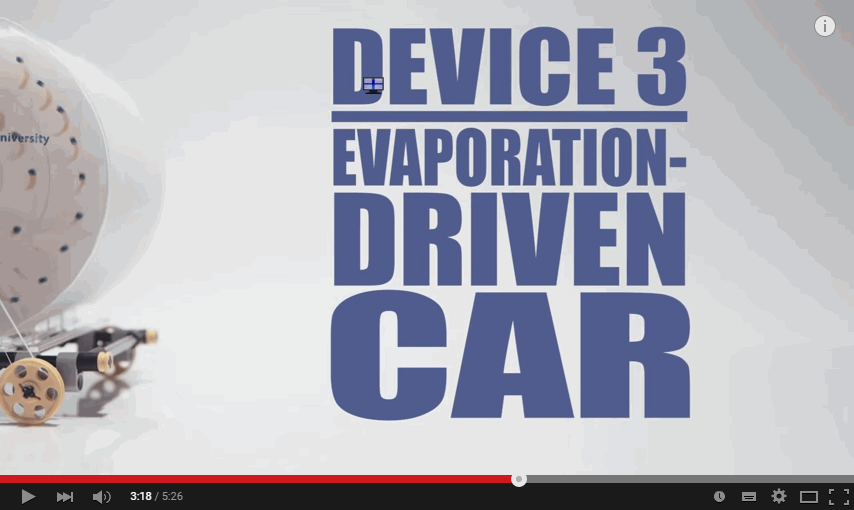
CREDIT
Sahin Laboratory, Columbia University
New clean energy source produces electricity, could power robots, sensors and vehicles
An immensely powerful yet invisible force pulls water from the earth to the top of the tallest redwood and delivers snow to the tops of the Himalayas. Yet despite the power of evaporating water, its potential to propel self-sufficient devices or produce electricity has remained largely untapped — until now.
In the June 16 online issue of Nature Communications, Columbia University scientists report the development of two novel devices that derive power directly from evaporation – a floating, piston-driven engine that generates electricity causing a light to flash, and a rotary engine that drives a miniature car.
When evaporation energy is scaled up, the researchers predict, it could one day produce electricity from giant floating power generators that sit on bays or reservoirs, or from huge rotating machines akin to wind turbines that sit above water, said Ozgur Sahin, Ph.D., an associate professor of biological sciences and physics at Columbia University and the paper’s lead author.
“Evaporation is a fundamental force of nature,” Sahin said. “It’s everywhere, and it’s more powerful than other forces like wind and waves.”
Last year, Sahin found that when bacterial spores shrink and swell with changing humidity, they can push and pull other objects forcefully. They pack more energy, pound for pound, than other materials used in engineering for moving objects, he reported in a paper published in Nature Nanotechnology, which was based on work Sahin had started as a Scholar in Residence at the Wyss Institute for Biologically Inspired Engineering at Harvard University.
Building on last year’s findings, Sahin and his Columbia colleagues sought to build actual devices that could be powered by such energy.
To build a floating, piston-driven engine, the researchers first glued spores to both sides of a thin, double-sided plastic tape akin to that in cassette tapes, creating a dashed line of spores. They did the same on the opposite side of the tape, but offset the line so dashes on one side overlapped with gaps on the other.
When dry air shrinks the spores, the spore-covered dashes curve. This transforms the tape from straight to wavy, shortening the tape. If one or both ends of the tape are anchored, the tape tugs on whatever it’s attached to. Conversely, when the air is moist, the tape extends, releasing the force. The result is a new type of artificial muscle that is controlled by changing humidity.
Sahin and Xi Chen, a postdoctoral fellow in his lab, then placed dozens of these tapes side by side, creating a stronger artificial muscle that they then placed inside a floating plastic case topped with shutters. Inside the case, evaporating water made the air humid. The humidity caused the muscle to elongate, opening the shutters and allowing the air to dry out. When the humidity escaped, the spores shrunk and the tapes contracted, pulling the shutters closed and allowing humidity to build again. A self-sustaining cycle of motion was born.
“When we placed water beneath the device, it suddenly came to life, moving on its own,” Chen said.
The spore-covered artificial muscles function as an evaporation-driven piston. Coupling that piston to a generator produced enough electricity to cause a small light to flash.
“We turned evaporation from a pool of water into light,” Sahin said.
With its current power output, the floating evaporation engine could supply small floating lights or sensors at the ocean floor that monitor the environment, Chen said, speculating that an improved version with stickier plastic tape and more spores could potentially generate even more power per unit area than a wind farm.
The Columbia team’s other new evaporation-driven engine – the Moisture Mill – contains a plastic wheel with protruding tabs of tape covered on one side with spores. Half of the wheel sits in dry air, causing the tabs to curve, and the other half sits in humid environment, where the tabs straighten. As a result, the wheel rotates continuously, effectively acting as a rotary engine.
The researchers next built a small toy car, powering it with the Moisture Mill and were successful in getting the car to roll on its own, powered only by evaporation. In the future, Sahin said, it may be possible to design engines that use the mechanical energy stored in spores to propel a full-sized vehicle. Such an engine, if achieved, would require neither fuel to burn nor an electrical battery.
A larger version of the Moisture Mill could also produce electricity, Sahin said, suggesting a wheel that sits above a large body of water and evaporates saltwater, causing the wheel to rotate and generate electricity. This development would steadily produce as much electricity as a wind turbine, Sahin said.
Read more: Renewable energy from evaporating water
The Latest on: Evaporation engine
[google_news title=”” keyword=”Evaporation engine” num_posts=”10″ blurb_length=”0″ show_thumb=”left”]
via Google News
The Latest on: Evaporation engine
- Air quality alert affecting Jefferson and Shelby counties Wednesdayon April 30, 2024 at 7:08 am
Avoid use of gasoline power lawn and garden equipment. Refuel cars and trucks after 6 p.m. Limit engine idling. Use household, workshop, and garden chemicals in ways that keep evaporation to a minimum ...
- Think you understand evaporation? Think again, says MITon April 25, 2024 at 1:44 am
In other words, while it's true that evaporation has been happening all of these years due to fluctuations in temperature, water has also been turning to vapor from the force of light beams alone.
- “Drinking Bird” Becomes an Evaporation-Driven Triboelectricity Energy Harvesteron April 22, 2024 at 9:42 am
Researchers combined the drinking bird toy with a triboelectric arrangement to create a high-voltage energy-harvesting scheme.
- 11 Things To Know About Toyota's Hydrogen Combustion Engineon January 26, 2024 at 4:00 pm
The droplets of water injected dissipate heat through evaporation: they absorb heat, turn into steam, and exit the engine, cooling the engine without interfering with normal engine operations.
- P0442 Code: How To Fix Evaporative Emission Control System Leakon December 20, 2023 at 5:50 pm
The only thing that you will notice is an illuminated check engine light. The P0442 code indicates that there is a small leak in the evaporative emission control system (EVAP). The purpose of an ...
- What is evaporation and condensation?on October 12, 2023 at 10:53 am
And this process is called evaporation. When a gas cools down, it can change state back into a liquid. So when the warm steam hits the surface of, say, a cold mirror it turns back into water again.
- P0456 Code: How To Fix EVAP System Leak Detectedon September 14, 2023 at 5:43 am
It keeps the fuel vapors in the EVAP canister while the engine is not running. If there is a small fuel vapor leak anywhere in the EVAP system, that can trigger a P0456 code. The common reason for ...
- Evaporation Sensationon February 28, 2023 at 6:15 am
When water molecules do this, they change from liquid water to water vapor – a gas. This changing from a liquid to a gas is called evaporation. Heating a liquid causes the water molecules to move ...
- Evaporation in focuson April 24, 2022 at 2:23 am
However, as observational techniques that used to be restricted to research applications are entering operational mode, it is becoming possible to routinely measure evaporation and soil moisture ...
- Fuel Tank Pressure Sensoron January 28, 2022 at 12:22 am
Fuel vapors are supposed to be contained in the EVAP system, and leaks can allow vapors to escape into the atmosphere. The sensor is connected to the engine computer, and when the sensor detects a ...
via Bing News











